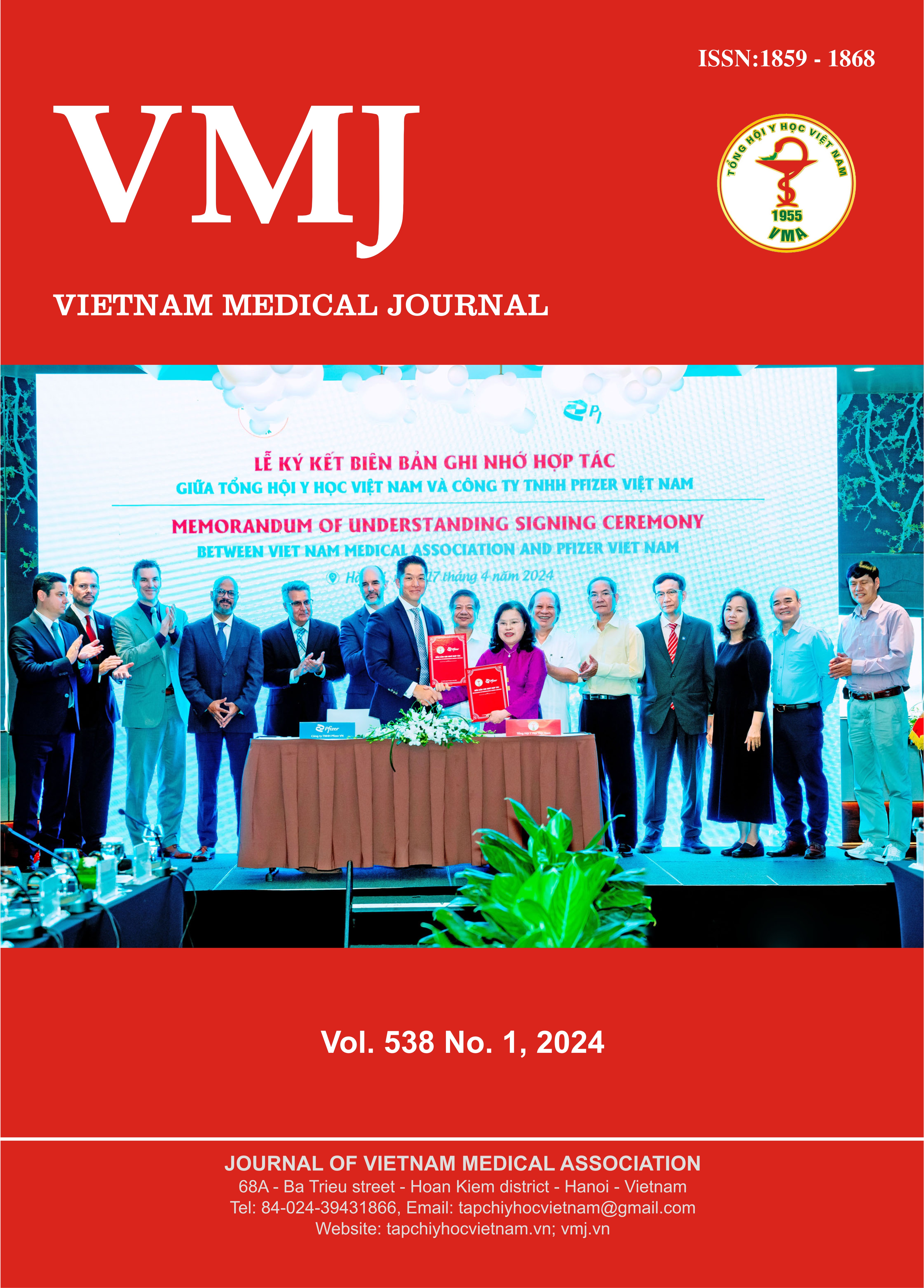EVALUATION OF EARLY OUTCOMES OF PERMANENT PACEMAKER IMPLANTATION IN HYPERTENSIVE PATIENTS WITH BRADYARRHYTHMIAS
Main Article Content
Abstract
Objective: This study aims to describe the clinical characteristics and the features of bradyarrhythmias on 24-hour Holter monitoring and to evaluate the early outcomes of permanent pacemaker implantation in hypertensive patients with bradyarrhythmias. Subjects and method: This cross-sectional study was conducted on 57 subjects with hypertension and bradyarrhythmias who were indicated for permanent pacemaker implantation. Results: The most common clinical symptoms recorded were fatigue, dizziness, and chest pain, accounting for 47.4%, 45.6%, and 42.1% respectively. The majority of patients had sinus node dysfunction (73.7%) and most underwent dual-chamber permanent pacemaker implantation (87.7%). The 24-hour Holter monitoring results showed that 42.1% had sinus atrial block - sinus pause in the sinus node dysfunction group and 15.8% of patients had third-degree atrioventricular block (AV block) in the AV block group. A good treatment outcome was observed in 72.0% of cases. Age > 70 (OR: 6.1; 95% CI: 1.2-30.1), female gender (OR: 4.2; 95% CI: 1.2-15.4), and single-chamber pacemaker (OR: 8.9; 95% CI: 1.5-52.1) were associated with a higher risk of moderate to poor treatment outcomes. Conclusion: Permanent pacemaker implantation generally tends to have good short-term outcomes. However, it should be noted that older age, female, and single-chamber pacemaker implantation in association with worse outcomes.
Article Details
Keywords
bradyarrhythmias, hypertension, single/dual-chamber permanent pacemaker
References
2. Doan CT, Ngo LS, Mai XA. Clinical and subclinical characteristics of patients before and after permanent dual-chamber pacemaker implantation at Hue Central Hospital. J Vietnamese Cardiol. 2021; 98:74-82.
3. Dretzke J., Toff W.D., Lip G.Y., Ret al. Dual chamber versus single chamber ventricular pacemakers for sick sinus syndrome and atrioventricular block. Cochrane Database Syst Rev. 2004; 2004(2):CD003710.
4. Egas D., Rodriguez F., Jaswal A., et al. Burden of bradycardia and barriers to accessing bradycardia therapy in underserved countries. Eur Heart J Suppl. 2023; 25(Suppl H):H1-H17.
5. Glikson M., Nielsen J.C., Kronborg M.B., et al. 2021 ESC Guidelines on cardiac pacing and cardiac resynchronization therapy: Developed by the Task Force on cardiac pacing and cardiac resynchronization therapy of the European Society of Cardiology (ESC) With the special contribution of the European Heart Rhythm Association (EHRA). Rev Esp Cardiol (Engl Ed). 2022; 75(5):430.
6. Greenspon A.J., Patel J.D., Lau E., et al. Trends in permanent pacemaker implantation in the United States from 1993 to 2009: increasing complexity of patients and procedures. J Am Coll Cardiol. 2012; 60(16):1540-5.
7. Kusumoto F.M., Goldschlager N. Pacemakers: types, function, and indications. Semin Cardiothorac Vasc Anesth. 2000; 4(3):122-137.
8. Kusumoto F.M., Schoenfeld M.H., Barrett C., et al. 2018 ACC/AHA/HRS Guideline on the evaluation and management of patients with bradycardia and cardiac conduction delay: executive summary: a report of the American College of Cardiology/American Heart Association Task Force on clinical practice guidelines, and the Heart Rhythm Society. J Am Coll Cardiol. 2019; 74(7):932-987.
9. Lamas G.A., Lee K., Sweeney M., et al. The mode selection trial (MOST) in sinus node dysfunction: design, rationale, and baseline characteristics of the first 1000 patients. Am Heart J. 2000; 140(4):541-551.
10. Lopez-Villegas A., Catalan-Matamoros D., Lopez-Liria R., et al. Health-related quality of life on tele-monitoring for users with pacemakers 6 months after implant: the NORDLAND study, a randomized trial. BMC Geriatr. 2018; 18(1):223.
11. Mancia G., Kreutz R., Brunström M., et al. 2023 ESH Guidelines for the management of arterial hypertension: The Task Force for the management of arterial hypertension of the European Society of Hypertension; Endorsed by the International Society of Hypertension (ISH) and the European Renal Association (ERA). J Hypertens. 2023; 41(12):1874-2071.
12. Markos S., Nasir M., Ahmed M., et al. Assessment of trend, indication, complications, and outcomes of pacemaker implantation in adult patients at tertiary hospital of Ethiopia: retrospective follow up study. Int J Gen Med. 2024; 17:93-103.
13. Onakpoya U.U., Ojo O.O., Eyekpegha O.J., Oguns A.E., Akintomide A.O. Early experience with permanent pacemaker implantation at a tertiary hospital in Nigeria. Pan Afr Med J. 2020; 36:177.
14. Schwaab B., Kindermann M., Schätzer-Klotz D., et al. AAIR versus DDDR pacing in the bradycardia tachycardia syndrome: a prospective, randomized, double-blind, crossover trial. Pacing Clin Electrophysiol. 2001 Nov;24(11):1585-1595.
15. Shah Syed A.R., Akram A., Azam M.S., et al. Dual-chamber versus single chamber pacemakers, a systemic review and meta-analysis on sick sinus syndrome and atrioventricular block patients. Heliyon. 2023; 10(1):e23877.


